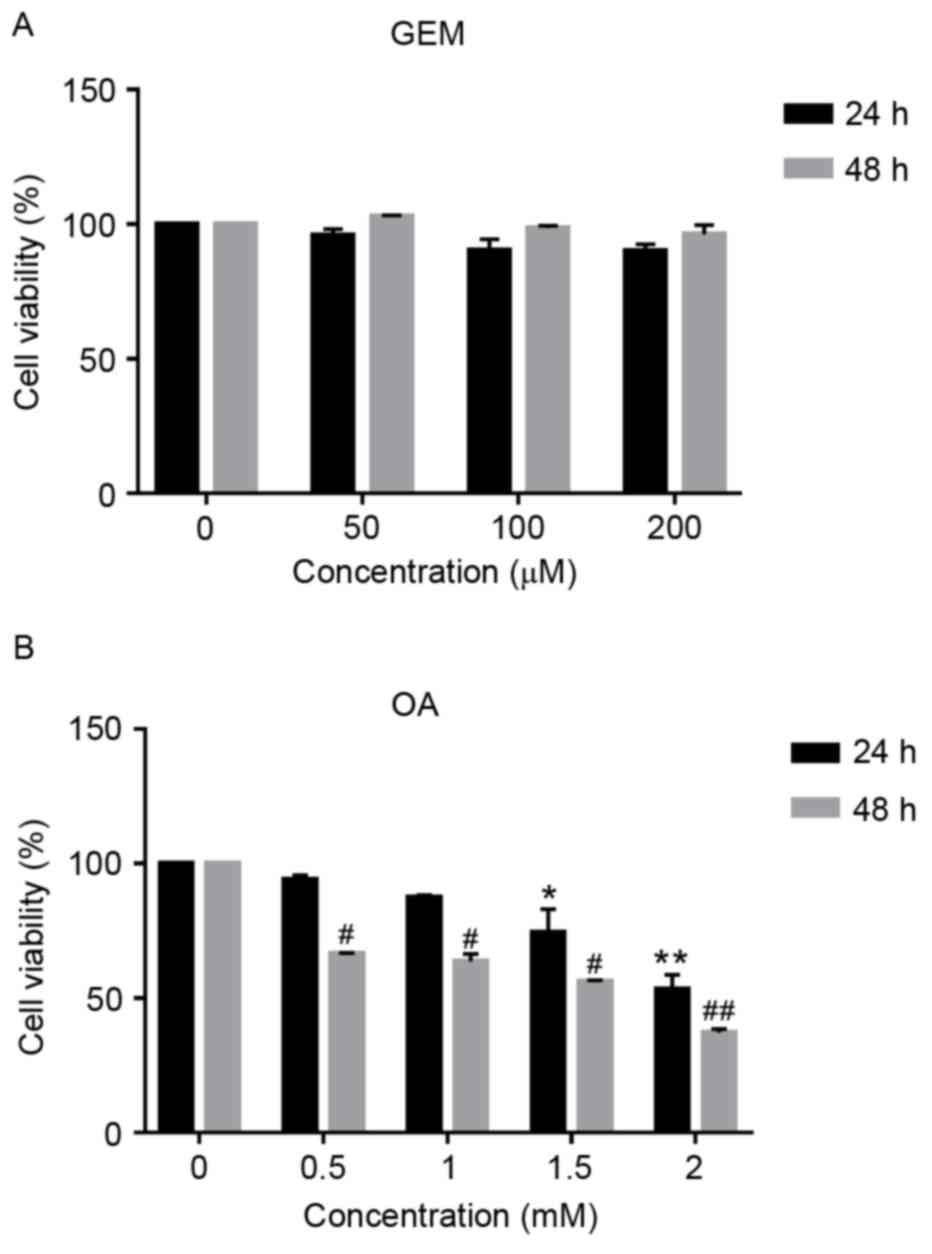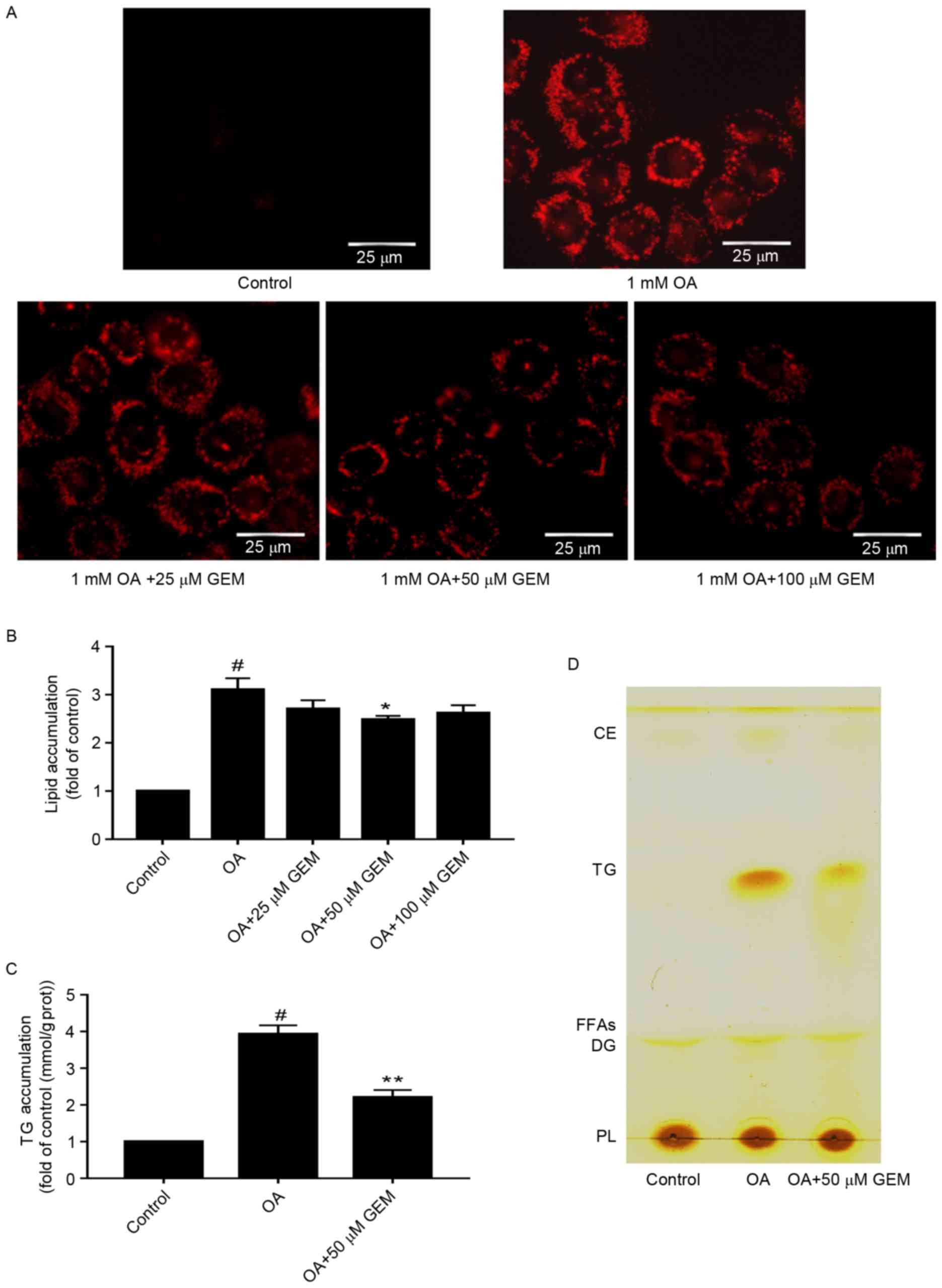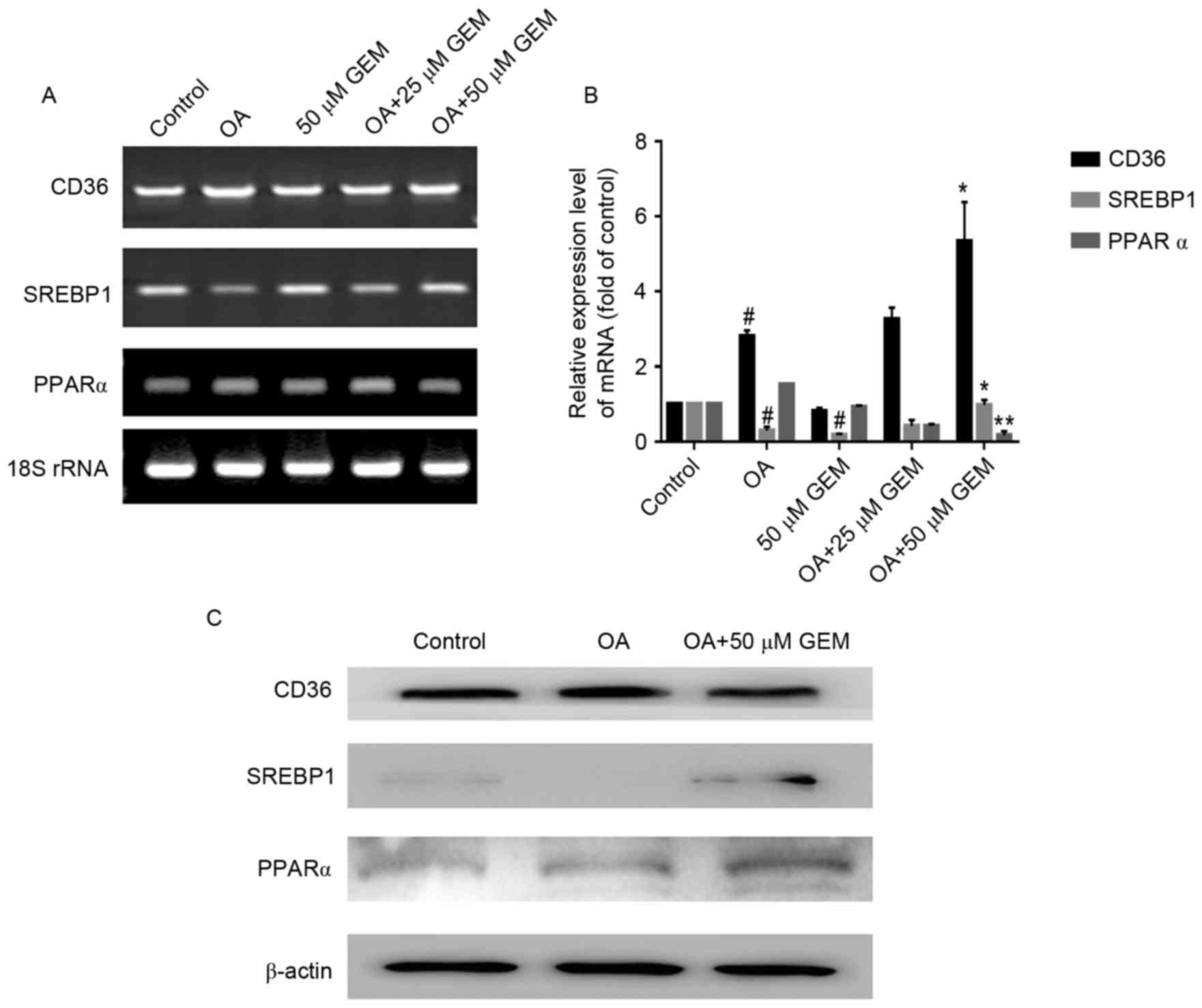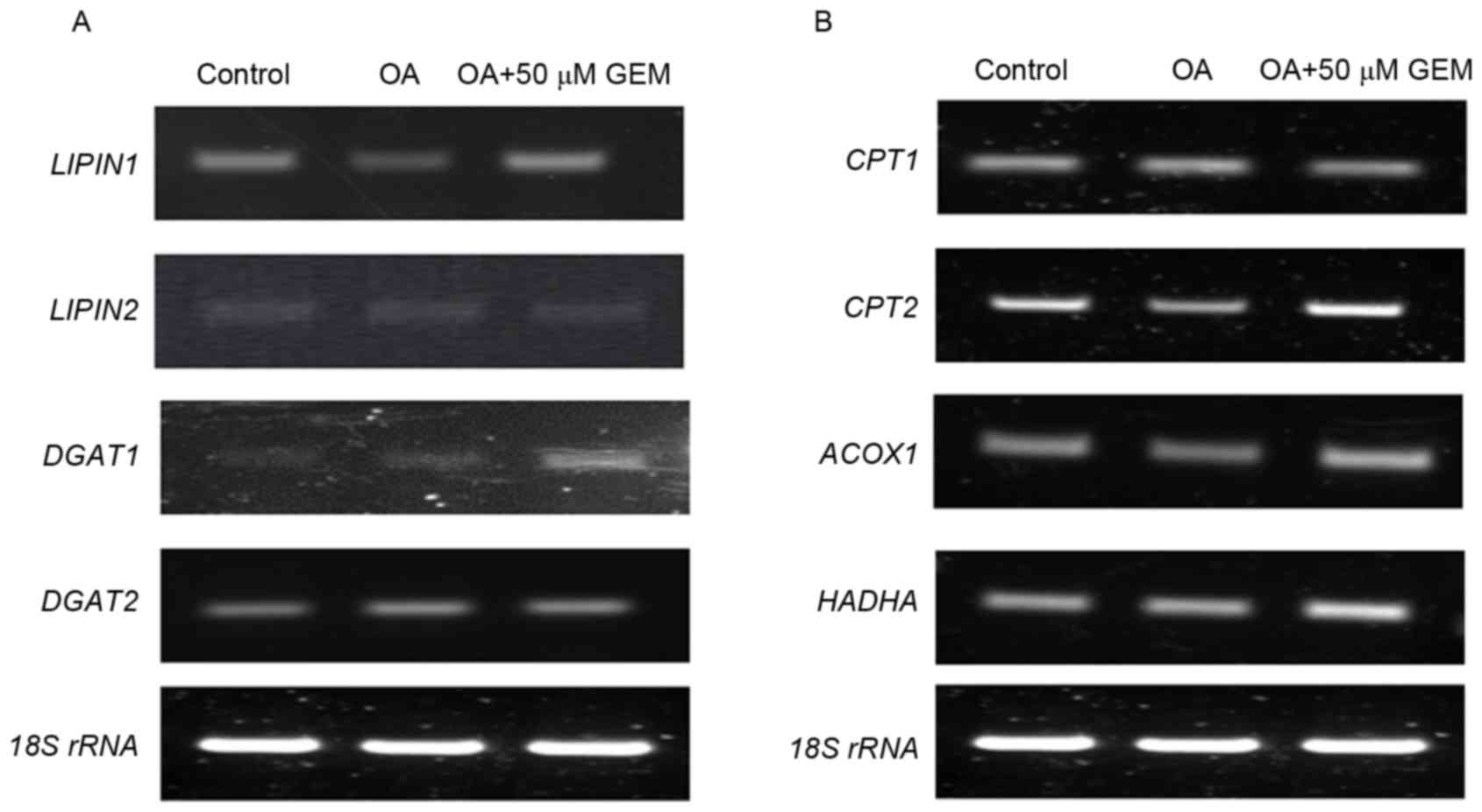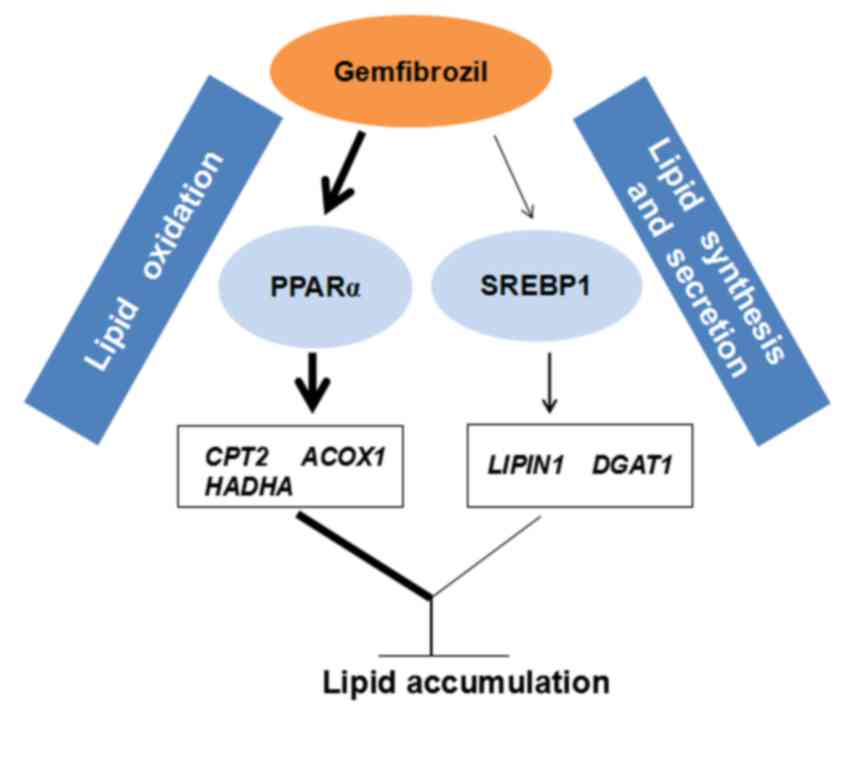Gemfibrozil reduces lipid accumulation in SMMC‑7721 cells via the involvement of PPARα and SREBP1
- Authors:
- Published online on: December 5, 2018 https://doi.org/10.3892/etm.2018.7046
- Pages: 1282-1289
-
Copyright: © Zhang et al. This is an open access article distributed under the terms of Creative Commons Attribution License.
Abstract
Introduction
Gemfibrozil (GEM) is a member of the fibrate class of lipid-lowering pharmaceuticals and has been widely used in the therapy of different forms of hyperlipidemia and hypercholesterolemia since the early 1970s (1). Fibrates act as agonists of the nuclear receptor peroxisome proliferator-activated receptor α (PPARα), which regulates gene expression for lipid catabolism and lipoprotein metabolism (2). Fibrates cause a moderate decrease in the content of plasma triglycerides (TG) and increase cholesterol level in high density lipoproteins (3). Clinical trials have demonstrated that fibrates have a benignant effect on vascular remodeling, inflammation, cardiovascular and coronary events (4,5). However, there is currently little understanding about the effects on fatty liver disease after drug treatment, particularly in hepatocytes.
Non-alcoholic fatty liver disease (NAFLD) includes a broad spectrum of liver injury, which is characterized by fat infiltration (steatosis) with a TG content >5% liver weight with no alcohol consumption, which is different from alcoholic fatty liver disease (6). NAFLD has been correlated with obesity, diabetes, insulin resistance, hypertriglyceridemia and cardiovascular diseases, and represents the hepatic manifestation of the metabolic syndrome (7–9). Furthermore, the development process of liver disease includes several stages, ranging from regional steatosis to nonalcoholic steatohepatitis, and even to serious liver disease, such as cirrhosis and hepatocellular carcinoma (10). It was estimated that the prevalence of NAFLD ranges from 17–33% in the general population of Western countries in 2003 (11). Unfortunately, current effective therapies for NAFLD are limited and therefore there is a critical requirement to identify the mechanisms of NAFLD. According to the two-hit theory, the hallmark of NAFLD is triacylglycerol accumulation in lipid droplets within hepatocytes (12,13). In the present study, oleate-treated human hepatoma SMMC-7721 cells were utilized as a model of steatosis (14,15) to investigate the role of GEM in regulating hepatic lipid metabolism.
Materials and methods
Antibodies and reagents
Cluster of differentiation (CD)36, sterol regulatory element-binding protein 1 (SREBP1) and PPARα antibodies were separately purchased from Santa Cruz Biotechnology, Inc., (Dallas, TX, USA). β-actin rabbit monoclonal antibody was purchased from Abcam (Cambridge, MA, USA). Secondary horseradish peroxidase-labeled goat anti-rabbit immunoglobulin G (H+L) was purchased from Novoprotein Scientific, Inc. (Summit, NJ, USA). GEM was purchased from Sigma-Aldrich (Merck KGaA, Darmstadt, Germany). Oleic acid (OA) and bovine serum albumin (BSA; fatty acid free) were obtained from Sangon Biotech Co., Ltd., (Shanghai, China).
Cell culture and treatment
Human hepatoma SMMC-7721 cells were supplied by the Institute of Cell Biology (Shanghai, China). The cells were cultured in RPMI-1640 medium (Gibco; Thermo Fisher Scientific, Inc., Waltham, MA, USA) supplemented with 10% fetal bovine serum (Biological Industry, Kibbutz Beit Haemek, Israel), 1% penicillin-streptomycin (10,000 U/ml penicillin and 10 mg/ml streptomycin; Beijing Solarbio Science & Technology Co., Ltd., Beijing, China) and maintained at 37°C with humidified air in 5% CO2. SMMC-7721 cells were first exposed to GEM when they reached 75% confluence. Different dilutions (10–200 µM) of GEM were made with DMSO and 10 µl of GEM solutions were then added to 1 ml culture medium, respectively. To investigate the effect of OA on fat-overloading, cultures were exposed to different concentrations of OA, diluted in 10% BSA, ranging from 0.5–2 mM.
Cell viability assay
To determine the effect of GEM or OA on SMMC-7721 cell viability, the cells were treated with GEM at different concentrations (0, 50, 100 and 200 µM) for 24 and 48 h at 37°C. Following this, 1×106 cells in 96-well plates were treated with OA at different concentrations (0, 0.5, 1, 1.5 and 2 mM) with 10% BSA overnight at 37°C, respectively. Cell viability was determined using Cell Counting kit-8 dye (Beyotime Institute of Biotechnology, Beijing, China), according to manufacturer's instructions. Absorbance was measured at 450 nm with a GENios multifunction-reader (Tecan GENios Pro; Tecan Group, Ltd., Männedorf, Switzerland).
Evaluation and quantification of lipid accumulation
Oil red O (Sangon Biotech Co. Ltd., Shanghai, China) was used to monitor the content of lipids in SMMC-7721 cells, according to the manufacturer's instructions. Cells were seeded in a 6-well plate at a density of 1.0×105 cells/well. Following adherence, cells were treated with GEM at different concentrations (0, 10, 25, 50 and 100 µM) together with 1 mM OA for 24 h at 37°C, respectively. Subsequently, cells were fixed overnight at 37°C with 4% paraformaldehyde and stained with Oil red O at 37°C for 30 min. Images were photographed with an inverted fluorescent microscope (Nikon Eclipse TI; Nikon Corp., Tokyo, Japan). Following this, Oil red O was extracted using isopropanol (100 µl) for 1 h at 37°C. Then the extracted sample was moved to another 96-well plate. Absorbance was measured at 510 nm in a spectrophotometer for quantitative analysis (16).
Extraction and quantification of TG
For quantitative estimation of TG, lipids were extracted from cells using Triton X-100 (2%) for 30 min at 37°C. An enzymatic assay was then performed using an EnzyChromTM Triglyceride Assay kit (Bioassay Systems LLC, Hayward, CA, USA), according to the manufacturer's protocols. Total lipid extraction and separation was conducted by thin layer chromatography (TLC), according to previous methods (16). The cell pellets were harvested by centrifugation at 1,000 × g for 5 min at 37°C, washed twice with phosphate-buffered saline (PBS), snap-frozen and smashed in 1 ml methanol chloroform mix (v/v, 2/1). These components were mixed well and then centrifuged at 12,000 × g for 5 min at room temperature to allow phase separation. The chloroform phase was transferred to a new tube and blow-dried. The lipid fractions were separated by TLC using a developing solvent (hexane/diethyl ether/acetic acid; 40:80:2, v/v/v). To visualize different fractions of total lipids extracted from cells, the TLC plate (Sinopharm Chemical Reagent Co., Ltd., Beijing, China) was stained with iodine vapor at 60°C for 30 min and photographed using a DNR Bio-Imaging System, Ltd. (Neve Yamin, Israel).
RNA isolation, reverse transcription-polymerase chain reaction (RT-PCR) and RT-quantitative PCR (RT-qPCR) analyses
Total RNA was extracted using RNAiso Plus (Takara Biotechnology Co. Ltd., Dalian, China), according to the manufacturer's instructions, and quantified using a NanoDrop 2000c (Thermo Fisher Scientific Inc., Waltham, MA, USA). First-strand cDNA synthesis (1 µg) and PCR reactions were performed using the PrimeScriptTM RT reagent kit with gDNA Eraser (Takara Biotechnology Co. Ltd., Dalian, China), according to the manufacturer's instructions. Following this, mRNA levels were determined by PCR (EmeraldAmp PCR MasterMix; Catalogue no. RR300A; Takara Biotechnology Co. Ltd., Dalian, China), as described in the study by Bergman et al (17). The primers were designed using Primer 5.0 software (Premier Biosoft International, Palo Alto, CA, USA) and are listed in Table I. 18S ribosomal (r)RNA was selected as an internal control. The PCR reaction conditions were as follows: 98°C for 10 sec, 55°C for 30 sec and 72°C for 1 min for a total 30 cycles. qPCR was performed in triplicate assays using SYBR Premix Ex Taq (Tli RNaseH Plus; catalogue no. RR420; Takara Biotechnology Co. Ltd., Dalian, China) in a CFX96 Real-Time PCR Detection System (Bio-Rad Laboratories, Inc., Hercules, CA, USA). The qPCR reaction conditions were as follows: Activation of the Taq DNA polymerase at 95°C for 30 sec, followed by 40 cycles of 95°C for 10 sec and 60°C for 32 sec. mRNA expression levels were analyzed by the 2−ΔΔCq method (18), relative to 18S rRNA expression.
Western blotting
Cells were incubated with either OA (1 mM) or OA together with GEM (50 µM) for 24 h at 37°C and lysed with pre-chilled radioimmunoprecipitation assay lysis buffer (Beyotime Institute of Biotechnology) for 30 min on ice. Following this, lysates were centrifuged at 13,000 × g for 20 min at 4°C and quantified by a Bradford protein assay (Bio-Rad Laboratories, Inc.) (19). Proteins (50 µg) were separated by 8% SDS-PAGE and transferred to Amersham Hybond-P polyvinylidene fluoride membranes (GE Healthcare Life Sciences, Little Chalfont, UK). Membranes were blocked with 5% milk powder in PBS for 2 h at 37°C and then incubated with primary specific antibodies overnight at 4°C, including CD36 (catalogue no. sc-9154; 1:2,000), PPARα (catalogue no. sc-9000; 1:1,000), SREBP1 (catalogue no. sc-8984; 1:1,000) and β-actin (catalogue no. ab8226; 1:5,000) rabbit monoclonal antibodies. The membrane was placed in PBS-Tween 20 (PBST) and cleaned 3 times for 10 min. Then samples were incubated with secondary horseradish peroxidase (HRP)-labeled goat anti-rabbit immunoglobulin G (H+L) (catalogue no. L153B; 1:1,000) at room temperature for 1.5 h. After completion of secondary antibody incubation, wash 3 times in PBST for 10 min/time Target proteins on the membranes were visualized using Pro-light HRP Chemiluminescent kit (cat. no. PA112; Tiangen Biotech Co., Ltd., Beijing, China) following the manufacturers protocol. The protein bands were analyzed by densitometry using ImageJ software, version 1.37 (National Institutes of Health, Bethesda, MD, USA) after exposure of the membranes to gel capture software, version 2.0 (DNR Bio-Imaging System, Ltd., Jerusalem, Israel).
Statistical analysis
All experiments were performed at least three times. Values were expressed as the mean ± standard deviation. Statistical analysis was performed using the Student's t-test using SPSS version 19.0 (IBM Corp., Armonk, NY, USA). P<0.05 was considered to indicate a statistically significant difference.
Results
Cytotoxicity of GEM in an in vitro hepatocellular model
Using the WST-8 based Colorimetric Assay Cell Counting kit-8, the effect of GEM on cell viability was measured. As demonstrated in Fig. 1A, no significant cytotoxic effect was observed in cells following treatment with GEM. Cell viability of SMMC-7721 cells was inhibited by 4.22, 9.72 and 9.55% at GEM concentrations of 50, 100 and 200 µM after 24 h, respectively. Cells were also exposed to different concentration of OA. The concentrations of OA were chosen according to our previous work (15). As demonstrated in Fig. 1B, OA inhibited cell viability in a dose- and time-dependent manner. When cells were cultured in the presence of OA at 0.5 and 1 mM for 24 h, they accumulated intracellular lipids without acute cytotoxic effect, while cell viability was significantly inhibited when treated with 1.5 and 2 mM OA for 24 and 48 h compared with 0 mM OA (P<0.05). Cell viability was decreased by 25.7 and 46.9% at 1.5 mM OA for 24 and 48 h, respectively and 44 and 62.9% at 2 mM OA for 24 and 48 h, respectively. Therefore, cells treated with 1 mM OA were used as the cellular model of NAFLD.
GEM ameliorates lipid accumulation
To determine whether GEM affects lipid accumulation in SMMC-7721 cells, cells were incubated with different concentrations of GEM and 1 mM OA. As demonstrated in Fig. 2A, a clear dose-dependent decrease in lipid accumulation was observed in the cells under the microscope. Furthermore, the total lipid levels were decreased by 12.9, 21 and 16.5% in cells incubated with GEM concentrations of 25, 50 and 100 µM, respectively (Fig. 2B). The results indicated that 50 µM of GEM significantly reduced levels of intracellular total lipids and TG compared with cells treated with 1 mM OA only (P<0.05; Fig. 2B and C). Therefore 50 µM was used for subsequent experiments and assessments. The level of cellular TG was detected and was observed to be decreased by 43.8% at 50 µM GEM compared with cells treated with 1 mM OA only (Fig. 2C). To further confirm the lipid changes in the cellular model, TLC analysis was performed. TLC results suggested that there was a decrease in TG levels in cells treated with 50 µM GEM compared with those treated with OA only (Fig. 2D). Taken together, GEM may lower the lipid accumulation in an in vitro model of NAFLD. The optimal concentration is 50 µM.
Changes to lipid metabolism-related mRNA and protein expression
RT-PCR and RT-qPCR analyses were employed to determine whether GEM was able to regulate lipid metabolism-related gene expression in SMMC-7721 cells. The results demonstrated that GEM (50 µM) significantly increased the levels of CD36, SREBP1 (P<0.05) and significantly reduced the levels of PPARα (P<0.01) in cells treated with 1 mM OA compared with cells treated with OA only (Fig. 3A and B). Subsequently, western blotting with specific antibodies was performed to detect the changes of related protein expression levels. The expression levels of SREBP1 and PPARα were markedly upregulated following treatment with GEM in the OA-overloaded cells. However, the level of CD36 in OA-overloaded cells treated with GEM showed no marked change compared with cells treated with OA only (Fig. 3C).
Confirmation of modulation of lipid synthesis and lipid oxidation
It is well recognized that lipogenic genes are commonly trans-activated by SREBP1, and this has critical central roles in the regulation of lipid synthesis (20). To validate the upregulation of SREBP1, the expression levels of its downstream target genes, such as LIPIN1, LIPIN2, diacylglycerol O-acyltransferase (DGAT)1 and DGAT2, were examined in the cells. The results demonstrated that mRNA levels of LIPIN1 and DGAT1 were markedly increased following treatment with GEM in cells treated with OA. However, mRNA expression levels of LIPIN2 and DGAT2 remained unchanged (Fig. 4A). As a transcription factor, PPARα has central roles in hepatic lipid oxidation, predominantly through regulating lipid target genes, such as carnitine palmitoyltransferase (CPT)1, CPT2, acyl-coA oxidase 1 (ACOX1) and hydroxyacyl-CoA dehydrogenase (HADHA) (21,22). Therefore, mRNA expression level changes of these genes were measured. The data demonstrated that mRNA levels of CPT2, ACOX1 and HADHA were significantly increased in the cellular model of NAFLD treated with GEM compared with the OA control, while the CPT1 mRNA expression level was not altered (Fig. 4B). Therefore, GEM may lower TG accumulation in OA-overloaded SMMC-7721 cells via the involvement of the PPARα and SREBP1 signaling pathways (Fig. 5).
Discussion
Previous studies have demonstrated that GEM functions as a PPARα agonist and is employed to treat hyperlipidemia and hypercholesterolemia (1,2,4). A study by Smith et al (23) reported that large significant declines in TG and smaller but significant declines in total lipids were the classical response to GEM treatment in patients with hypertriglyceridemia. In our laboratory, an in vitro hepatocellular steatosis model has been successfully established in human SMMC-7721 cells by using OA (15). In the present paper, the effect of GEM on this cellular model was examined. The present results demonstrated that GEM affected the expression levels of genes and proteins related to lipid metabolism, leading to a decrease in the lipid content and TG level in the fat over-accumulating hepatocytes.
PPARα belongs to the nuclear receptor family and is responsible for the regulation of lipid metabolism (24). The roles of PPARα in hepatic lipid homeostasis are well established, it governs β-oxidation to decrease lipid storage (25). PPARα agonist treatment protects wild type mice fed a methionine choline deficient (MCD) diet from both steatosis and steatohepatitis by preventing hepatic lipid accumulation (26). The results of the present study demonstrated that mRNA and protein levels of PPARα were altered in OA-overloaded SMMC-7721 cells treated with GEM, which was consistent with an increase in the expression levels of CPT2, ACOX1 and HADHA. A study by Ogata et al (27) observed the increase of hepatic lipid oxidation in rats on a high fat diet supplemented with GEM. GEM increased mRNA abundance of PPARα, as well as several of its downstream targets in the male goldfish and zebrafish (28,29). In the current study, the mRNA expression levels of PPARα decreased while the protein expression of PPARα was increased following treatment with GEM. Therefore, the present results demonstrated further that GEM functions as a PPARα agonist to activate lipid oxidation, leading to the reduction of excessive intracellular TG content in the hepatic steatosis model.
In addition, the present study indicated that GEM induced an increase in the mRNA and protein levels of SREBP1, accompanied by an increase in LIPIN1 and DGAT1 mRNA. SREBP1 is an important regulator of various genes involved in hepatic lipid metabolism and homeostasis (30). SREBP1 is a transcription factor that controls the anabolic pathways of cholesterol, free fat acids (FFAs) and TG (31). In FFA metabolism, SREBP-1 upregulates the expression of de novo lipogenesis via fatty acid synthase (32). Elevated SREBP-1c increases lipogenic gene expression, enhances fatty acid synthesis and accelerates TG accumulation in mice (33). As one of the downstream target genes of SREBP-1, LIPIN1 has been reported to encode significant hepatic phosphatidic acid phosphatase (PAP) activity (34). LIPIN1 deficiency is associated with lipodystrophy and hepatic steatosis in mice (35). DGAT activities catalyze the synthesis of TG in lipid droplets for storage or in nascent lipoproteins for secretion (36). Additionally, inhibition of DGAT1 increased triacylglycerol secretion, while inactivation of DGAT1 promoted large lipid droplet formation (37). From the present results, it is evident that GEM is involved in TG synthesis and secretion.
CD36 is a membrane-associated protein that facilitates the uptake of chylomicron and very low density lipoprotein remnants, as well as long-chain FFAs (38,39). Elevated CD36 expression is involved in steatosis of animal models (40,41). In patients with NAFLD and chronic hepatitis C virus, upregulation of CD36 expression is also detected (42). However, it appeared that the expression of CD36 was not affected by GEM in the present in vitro model.
In conclusion, GEM lowers TG accumulation in OA-overloaded SMMC-7721 cells via the involvement of the PPARα and SREBP1 signaling pathways, which enhances lipid oxidation and interferes with lipid synthesis and secretion. The present results strongly suggest that GEM may potentially be utilized for the treatment of NAFLD.
Acknowledgements
The present work was sponsored by grants from Shanghai Scientific and Technological Innovation Project (grant no. 14520720700) and State Education Ministry and Fundamental Research Funds for the Central Universities (grant no. 222201313010).
Competing interests
The authors declare that they have no competing interests.
References
|
Fruchart JC and Duriez P: Mode of action of fibrates in the regulation of triglyceride and HDL-cholesterol metabolism. Drugs Today (Barc). 42:39–64. 2006. View Article : Google Scholar : PubMed/NCBI | |
|
Mandard S, Müller M and Kersten S: Peroxisome proliferator-activated receptor alpha target genes. Cell Mol Life Sci. 61:393–416. 2004. View Article : Google Scholar : PubMed/NCBI | |
|
Chinetti-Gbaguidi G, Fruchart JC and Staels B: Pleiotropic effects of fibrates. Curr Atheroscler Rep. 7:396–401. 2005. View Article : Google Scholar : PubMed/NCBI | |
|
Jun M, Foote C, Lv J, Neal B, Patel A, Nicholls SJ, Grobbee DE, Cass A, Chalmers J and Perkovic V: Effects of fibrates on cardiovascular outcomes: A systematic review and meta-analysis. Lancet. 375:1875–1884. 2010. View Article : Google Scholar : PubMed/NCBI | |
|
Keech A, Simes RJ, Barter P, Best J, Scott R, Taskinen MR, Forder P, Pillai A, Davis T, Glasziou P, et al: Effects of long-term fenofibrate therapy on cardiovascular events in 9,795 people with type 2 diabetes mellitus (the FIELD study): Randomised controlled trial. Lancet. 366:1849–1861. 2005. View Article : Google Scholar : PubMed/NCBI | |
|
Kleiner DE, Brunt EM, Van Natta M, Behling C, Contos MJ, Cummings OW, Ferrell LD, Liu YC, Torbenson MS, Unalp-Arida A, et al: Design and validation of a histological scoring system for nonalcoholic fatty liver disease. Hepatology. 41:1313–1321. 2005. View Article : Google Scholar : PubMed/NCBI | |
|
Brunt EM: Pathology of nonalcoholic fatty liver disease. Nat Rev Gastroenterol Hepatol. 7:195–203. 2010. View Article : Google Scholar : PubMed/NCBI | |
|
Ajmal MR, Yaccha M, Malik MA, Rabbani MU, Ahmad I, Isalm N and Abdali N: Prevalence of nonalcoholic fatty liver disease (NAFLD) in patients of cardiovascular diseases and its association with hs-CRP and TNF-α. Indian Heart J. 66:574–579. 2014. View Article : Google Scholar : PubMed/NCBI | |
|
Narasimhan S, Gokulakrishnan K, Sampathkumar R, Farooq S, Ravikumar R, Mohan V and Balasubramanyam M: Oxidative stress is independently associated with non-alcoholic fatty liver disease (NAFLD) in subjects with and without type 2 diabetes. Clin Biochem. 43:815–821. 2010. View Article : Google Scholar : PubMed/NCBI | |
|
Duan XY, Zhang L, Fan JG and Qiao L: NAFLD leads to liver cancer: Do we have sufficient evidence? Cancer Lett. 345:230–234. 2014. View Article : Google Scholar : PubMed/NCBI | |
|
Shifflet A and Wu YG: Non-alcoholic steatohepatitis: An overview. J Formos Med Assoc. 108:4–12. 2009. View Article : Google Scholar : PubMed/NCBI | |
|
Day CP and James OF: Steatohepatitis: A tale of two ‘hits’? Gastroenterology. 114:842–845. 1998. View Article : Google Scholar : PubMed/NCBI | |
|
Musso G, Gambino R and Cassader M: Recent insights into hepatic lipid metabolism in non-alcoholic fatty liver disease (NAFLD). Prog Lipid Res. 48:1–26. 2009. View Article : Google Scholar : PubMed/NCBI | |
|
Cui W, Chen SL and Hu KQ: Quantification and mechanisms of oleic acidinduced steatosis in HepG2 cells. Am J Transl Res. 2:95–104. 2010.PubMed/NCBI | |
|
Wang S, Kuang X, Fang ZJ, Huang Z and Shi P: Effect of oleic acid on the levels of eight metal ions in human hepatoma SMMC-7721 cells. Biol Trace Elem Res. 159:445–450. 2014. View Article : Google Scholar : PubMed/NCBI | |
|
Ramírez-Zacarías JL, Castro-Muñozledo F and Kuri-Harcuch W: Quantitation of adipose conversion and triglycerides by staining intracytoplasmic lipids with Oil red O. Histochemistry. 6:493–497. 1992. View Article : Google Scholar | |
|
Bergman AC, Benjamin T, Alaiya A, Waltham M, Sakaguchi K, Franzén B, Linder S, Bergman T, Auer G, Appella E, et al: Identification of gel-separated tumor marker proteins by mass spectrometry. Electrophoresis. 21:679–686. 2000. View Article : Google Scholar : PubMed/NCBI | |
|
Livak KJ and Schmittgen TD: Analysis of relative gene expression data using real-time quantitative PCR and the 2(-Delta Delta C(T)) method. Methods. 25:402–408. 2001. View Article : Google Scholar : PubMed/NCBI | |
|
Bradford MM: A rapid and sensitive method for quantitation of microgram quantities of protein utilizing the principle of protein-dye binding. Anal Biochem. 72:248–254. 1976. View Article : Google Scholar : PubMed/NCBI | |
|
Brown MS and Goldstein JL: The SREBP pathway: Regulation of cholesterol metabolism by proteolysis of a membrane-bound transcription factor. Cell. 89:331–340. 1997. View Article : Google Scholar : PubMed/NCBI | |
|
Huang H, McIntosh AL, Martin AG, Petrescu AD, Landrock KK, Landrock D, Kier AB and Schroeder F: Inhibitors of fatty acid synthesis induce PPAR α-regulated fatty acid β-oxidative genes: Synergistic roles of L-FABP and glucose. PPAR Res. 2013:804–865. 2013. View Article : Google Scholar | |
|
Bishop-Bailey D: Peroxisome proliferator-activated receptors in the cardiovascular system. Br J Pharmacol. 129:823–834. 2000. View Article : Google Scholar : PubMed/NCBI | |
|
Smith WJ, Wang J, Dang AQ, Reeves C, Bibbs D and Faas FH: Gemfibrozil lowers plasma lipids and increases polyunsaturated fatty acid content and oxidative susceptibility of lipoproteins in hypertriglyceridemia. Clin Chim Acta. 322:77–84. 2002. View Article : Google Scholar : PubMed/NCBI | |
|
Uchida A, Slipchenko MN, Cheng JX and Buhman KK: Fenofibrate, a peroxisome proliferator-activated receptor α agonist, alters triglyceride metabolism in enterocytes of mice. Biochim Biophys Acta. 1811:170–176. 2011. View Article : Google Scholar : PubMed/NCBI | |
|
Peters JM, Rusyn I, Rose ML, Gonzalez FJ and Thurman RG: Peroxisome proliferator-activated receptor alpha is restricted to hepatic parenchymal cells, not Kupffer cells: Implications for the mechanism of action of peroxisome proliferators in hepatocarcinogenesis. Carcinogenesis. 21:823–826. 2000. View Article : Google Scholar : PubMed/NCBI | |
|
Fernández-Rojo MA, Restall C, Ferguson C, Martel N, Martin S, Bosch M, Kassan A, Leong GM, Martin SD, McGee SL, et al: Caveolin-1 orchestrates the balance between glucose and lipid-dependent energy metabolism: Implications for liver regeneration. Hepatology. 55:1574–1584. 2012. View Article : Google Scholar : PubMed/NCBI | |
|
Ogata M, Tsujita M, Hossaina MA, Akita N, Gonzalez FJ, Staels B, Suzuki S, Fukutomi T, Kimura G and Yokoyama S: On the mechanism for PPAR agonists to enhance ABCA1 gene expression. Atherosclerosis. 205:413–419. 2009. View Article : Google Scholar : PubMed/NCBI | |
|
Mimeault C, Trudeau VL and Moon TW: Waterborne gemfibrozil challenges the hepatic antioxidant defense system and down-regulates peroxisome proliferator activated receptor beta (PPARbeta) mRNA levels in male goldfish (Carassius auratus). Toxicology. 228:140–150. 2006. View Article : Google Scholar : PubMed/NCBI | |
|
Passeri MJ, Cinaroglu A, Gao C and Sadler KC: Hepatic steatosis in response to acute alcohol exposure in zebrafish requires sterol regulatory element binding protein activation. Hepatology. 49:443–452. 2009. View Article : Google Scholar : PubMed/NCBI | |
|
Li W, Tai Y, Zhou J, Gu W, Bai Z, Zhou T, Zhong Z, McCue PA, Sang N, Ji JY, et al: Repression of endometrial tumor growth by targeting SREBP1 and lipogenesis. Cell Cycle. 11:2348–2358. 2012. View Article : Google Scholar : PubMed/NCBI | |
|
Stone SJ, Myers HM, Watkins SM, Brown BE, Feingold KR, Elias PM and Farese RV Jr: Lipopenia and skin barrier abnormalities in DGAT2-deficient mice. J Biol Chem. 279:11767–11776. 2004. View Article : Google Scholar : PubMed/NCBI | |
|
Sumida Y, Niki E, Naito Y and Yoshikawa: Involvement of free radicals and oxidative stress in NAFLD/NASH. Free Radical Res. 47:869–880. 2004. View Article : Google Scholar | |
|
Horton JD, Bashmakov Y, Shimomura I and Shimano H: Regulation of sterol regulatory element binding proteins in livers of fasted and refed mice. Proc Natl Acad Sci USA. 95:5987–5992. 1998. View Article : Google Scholar : PubMed/NCBI | |
|
Kok BP, Dyck JR, Harris TE and Brindley DN: Differential regulation of the expressions of the PGC-1α splice variants, lipins, and PPARα in heart compared to liver. J Lipid Res. 54:1662–1677. 2013. View Article : Google Scholar : PubMed/NCBI | |
|
Péterfy M, Phan J, Xu P and Reue K: Lipodystrophy in the fld mouse results from mutation of a new gene encoding a nuclear protein. Lipin Nat Genet. 27:121–124. 2001. View Article : Google Scholar : PubMed/NCBI | |
|
Yen CLE, Stone SJ, Koliwad S, Harris C and Farese RV Jr: Thematic review series: Glycerolipids. DGAT enzymes and triacylglycerol biosynthesis. J Lipid Res. 49:2283–2301. 2008. View Article : Google Scholar : PubMed/NCBI | |
|
Li C, Li L, Lian J, Watts R, Nelson R, Goodwin B and Lehner R: Roles of Acyl-CoA: Diacylglycerol acyltransferases 1 and 2 in triacylglycerol synthesis and secretion in primary hepatocytes. Arterioscl Throm Vas. 35:1080–1091. 2015. View Article : Google Scholar | |
|
Ibrahimi A and Abumrad NA: Role of CD36 in membrane transport of long-chain fatty acids. Curr Opin Clin Nutr. 5:139–145. 2002. View Article : Google Scholar | |
|
Kennedy DJ, Kuchibhotla S, Westfall KM, Silverstein RL, Morton RE and Febbraio M: A CD36-dependent pathway enhances macrophage and adipose tissue inflammation and impairs insulin signalling. Cardiovasc Res. 89:604–613. 2011. View Article : Google Scholar : PubMed/NCBI | |
|
Ouwens DM, Diamant M, Fodor M, Habets DDJ, Pelsers MMAL, El Hasnaoui M, Dang ZC, van den Brom CE, Vlasblom R, Rietdijk A, et al: Cardiac contractile dysfunction in insulin-resistant rats fed a high-fat diet is associated with elevated CD36-mediated fatty acid uptake and esterification. Diabetologia. 50:1938–1948. 2007. View Article : Google Scholar : PubMed/NCBI | |
|
Koonen DP, Jacobs RL, Febbraio M, Young ME, Soltys CL, Ong H, Vance DE and Dyck JR: Increased hepatic CD36 expression contributes to dyslipidemia associated with diet-induced obesity. Diabetes. 56:2863–2871. 2007. View Article : Google Scholar : PubMed/NCBI | |
|
Miquilena-Colina ME, Lima-Cabello E, Sánchez-Campos S, García-Mediavilla MV, Fernández-Bermejo M, Lozano-Rodríguez T, Vargas-Castrillón J, Buqué X, Ochoa B, Aspichueta P, et al: Hepatic fatty acid translocase CD36 upregulation is associated with insulin resistance, hyperinsulinaemia and increased steatosis in non-alcoholic steatohepatitis and chronic hepatitis C. Gut. 60:1394–1402. 2011. View Article : Google Scholar : PubMed/NCBI |



